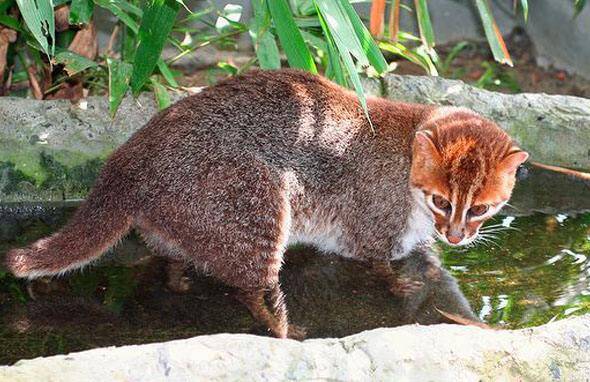Prionailurus planiceps
IUCN
LCBasic Information
Scientific classification
- name:Prionailurus planiceps
- Scientific Name:Prionailurus planiceps,Flat-headed Cat,Flat head cat
- Outline:Carnivora
- Family:Schizopoda Felidae Ocelot
Vital signs
- length:41-50cm
- Weight:1.5-2.5kg
- lifetime:About 14 years
Feature
Slightly long skull, flat top, short limbs, short and round ears
Distribution and Habitat
Distributed in Brunei Darussalam, Indonesia (Kalimantan, Sumatra), Malaysia (Peninsular Malaysia, Sabah, Sarawak). Possibly extinct: Thailand.
The flat-headed ocelot lives in lowland tropical rainforests, inhabiting secondary and primary forests, with many reports of sightings near water. Like other cats, this species is generally solitary and maintains its territory by scent.
Appearance
The flat-headed ocelot is about the same size as a domestic cat, with a male head-body length of 42-50 cm, a tail length of 13-20 cm, and a weight of 1.5-2.75 kg; the female head-body length is 33-37 cm, the tail length is 15-17 cm, and the weight is 1.5 kg. They have a long body, but the legs and tail are relatively short, and there are some vague horizontal stripes on the legs. The hair is dense and soft, with reddish brown on the head and dark brown on the body. The hair on the mouth, cheeks, chin and abdomen is white, and there are sometimes some dark brown spots on the abdomen. The eyes are round and large, and the distance between the eyes is quite close, which can help them get maximum binocular vision. There is a white stripe on each side of the nose and under the eyes, and two dark brown stripes on each cheek.
The molars of the flat-headed ocelot are larger and more pointed than those of other cats, so that they can firmly bite those slippery water prey without worrying abo
Details
Flat-headed Cat (scientific name: Prionailurus planiceps), also known as Flat-headed Cat, or simply Flat-headed Cat, is a small wild cat with no subspecies.

Flat-headed ocelots appear at dusk and dawn, and hunt at night or dawn. They mainly prey on frogs, fish and crustaceans, and also catch rats and chickens. They have long premolars and their claws cannot be retracted. This is similar to the semi-aquatic weasel family, which can enter the water at any time. After observing the captive flat-headed ocelots, they love to play in the water and will submerge their entire heads in the water to grab things placed in the water, such as fish pieces or toys. It is said that they even wash things in the water like raccoons.
In terms of reproductive characteristics, the gestation period of female cats is about 56 days, and each litter can give birth to about 1-4 cubs. The fur color of the cubs seems to be similar to that of the big cats, but it is slightly gray. After about 1 year, the fur color of the babies is the same as that of the big cats. The lifespan of wild species is 14 years.
The main threats to the survival of the flat-headed ocelots are water pollution and deforestation. In addition, as human settlements continue to expand, the filling of waterways will also threaten the survival of this rare animal that relies on water sources. Their rarity in the wild makes it impossible for humans to know their population numbers. Although humans listed them in Appendix I of CITES in 1975, this cannot change the terrible situation of water pollution and habitat loss, so the road ahead of them is still narrow and difficult. The number of adults is less than 10,000, and none of its subpopulations has more than 1,000. They are threatened by habitat loss and water pollution. They are fully protected except in Brunei.
Listed in the 2015 Red List of Endangered Species of the World Conservation Union (IUCN) ver 3.1-Endangered (EN).
Listed in the CITES Appendix I of the Washington Convention on the Protection of Animals.
Protect wild animals and stop eating game.
Maintaining ecological balance is everyone's responsibility!








